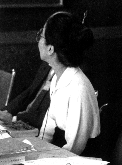|
|
Distancing Ji2
|
|
|
|
A
Taeko Brooks, University
of Massachusetts at Amherst
Abstract It is still maintained by some scholars that Confucius either wrote the Chun/Chyou (CC) or inserted into it valuational words of his own, creating a code which it is the function of the Dzwo Jwan and other commentaries to decipher. I agree that there are valuational words in the text, but in my work so far, I find that those words can be sufficiently explained as reflecting the valuations of the Lu court at the time the CC chronicle was compiled (08th through 06th centuries), and that we need not posit a later process whereby the value judgements of later critics were inserted into the text. In this paper I take up the coverb ji2
The basic mechanism for conveying the idea of "and" in the CC text is simple juxtaposition, without coverbs or other devices of connection. For instance, the usual way to report the participants at a covenant (mvng) is simply to list them, one after the other. When ji2 does appear in such a list, we thus expect it to carry some nuance of meaning. The primary nuance seems to be that the items following ji2 are in one way or another of lesser priority than the one preceding. Extended senses, which seem to be context-dependent, are a reluctance to be associated with an action, or outright antagonism to the parties named after the ji2. All these can be explained as stages of a natural semantic development from the basic verbal meaning of ji2, "to overtake, go as far as, go up to; additionally, including." Most generally, I find that ji2 in use functions, not as the conjunction we expect, but more exactly as a disjunction marker [Note 1]. Its various uses in dividing a list into portions of higher and lower relevance may be regarded as extension signals, reluctance indicators, or enmity markers. The CC itself provides contextual information in a sufficient number of cases to make it likely that the distancing sense conveyed by ji2 is a reflection of the social and political perceptions of the Lu court at the time the record was made. No hypothesis of later amendment or insertion, and no scenario of retrospective judgement of persons or events, seems to be required. I believe this preserves the CC as primary evidence for the events of the 08th through 06th centuries, and that the data on ji2 in particular may also, if judiciously applied, furnish some information about the mental states of those centuries. Notes Note 1. On the advice of Christoph Harbsmeier, in the discussion following the presentation of this paper, I have abandoned this term, which is pre-empted by other technical senses, and have instead titled my paper "Distancing" Ji2. [1 Nov 03]
All lectures and abstracts posted on this site are Copyright © by their authors. 26 Apr 2003 / Contact The Project / Conferences Page |
